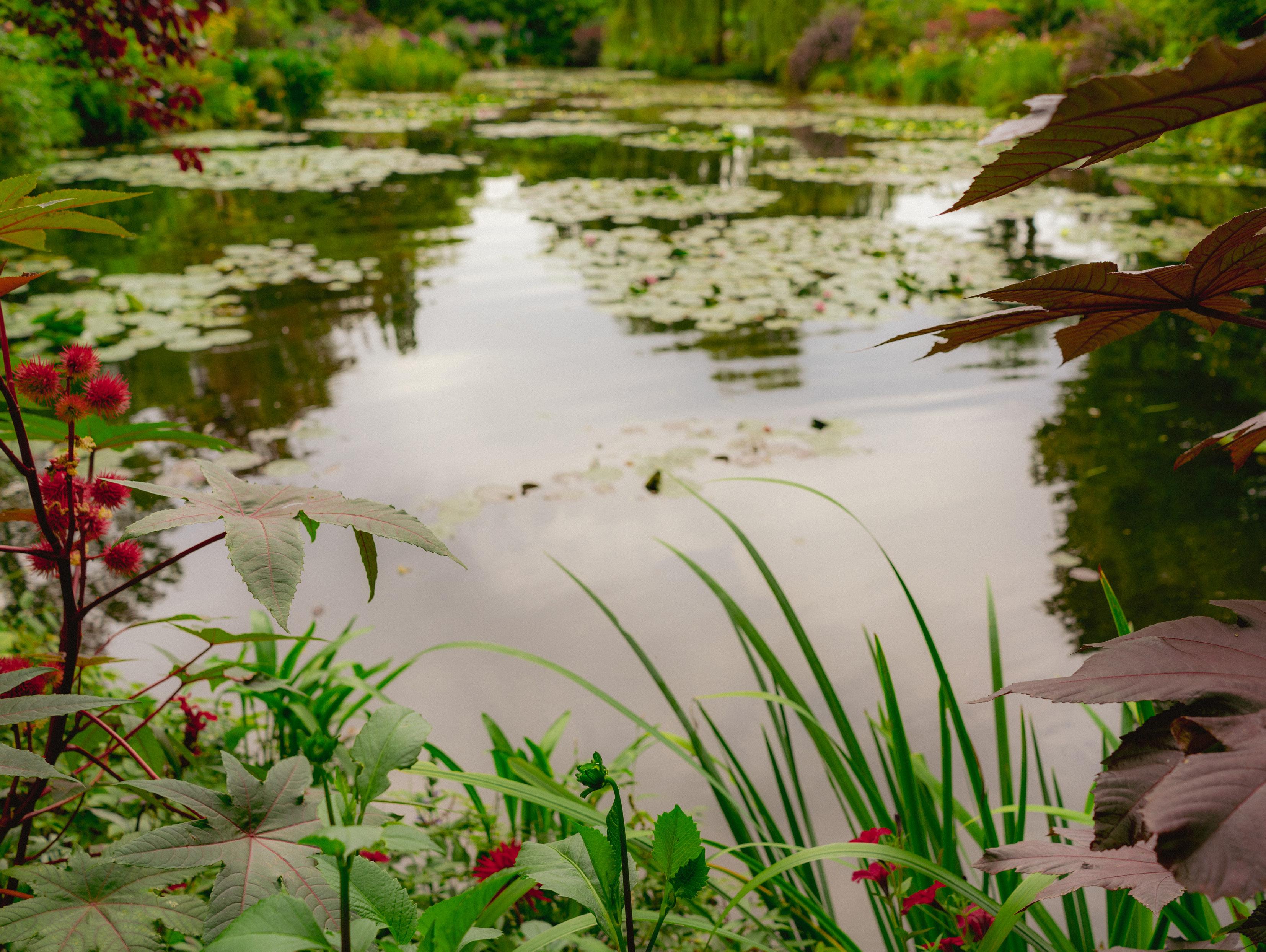

INNER IMPRESSIONS
LIUDMILA GEORGIEVSKAYA PIANO

FEDERICO MOMPOU
(1893-1987)
Impresiones íntimas (1911-14/Rev. 1959)
1. I. Lento cantabile espressivo 01'13
2. II. Larguetto 02'12
3. III. Gracioso 00'31
4. IV. Agitato 01'14
5. Pájaro triste. Largo 03'23
6. La barca. Largo 02'02
7. Cuna
8. Secreto. Lento
9. Gitano. Andante. Inquieto - ritmado 03'16
PYOTR ILYICH TCHAIKOVSKY
(1840-1893)
10. Dumka (Russian rustic scene), Op. 59 (1886) 09'36
From 16 Songs for Children, Op. 54 (1883)
Piano arrangement by Samuil Feinberg (1890-1962)
11. I. Spring 01'41
12. II. My Little Garden
13. III. Child’s Song

14. Lament, nocturne on two themes from 05’16
‘The Snow Maiden’, Op. 12 (1873)
Piano arrangement by Alexander Siloti (1863-1945)
15. Waltz in F-sharp minor, Op. 40, No. 9 (1878) 05’50
16. Romance in F minor, Op. 5 (1868) 06’18
JOAQUÍN RODRIGO
(1901-1999)
Cuatro estampas andaluzas (1946-52)
17. I. El vendedor de chanquetes 02’13
18. II. Crepúsculo sobre el Guadalquivir 03’59
19. III. Seguidillas del diablo 04’44
20. IV. Barquitos de Cádiz 05’27
Total Play Time: 69’38
Liudmila Georgievskaya piano



















All these pieces are, in essence, inner impressions, as in Mompou’s evocative title of one of the sets included in this album, Impresiones íntimas. These works form a collection of deeply inward, lyrical pieces. Some of them are songs or song-like; some are pictorial scenes in which even the loudest passages may sound profound and introverted.


The three transcriptions by Feinberg are from Tchaikovsky’s Songs for Children, while the one by Siloti comes from the music for the fairy tale The Snow Maiden by the same author. Images of childhood play an important role in this collection, as they are the ones that preserve in us that pure, naïve and spontaneous sentiment that is so necessary for emotional and spiritual survival in adulthood. Many of the titles in the Mompou and Rodrigo cycles are descriptive (‘The Boat’, ‘The Sad Bird’, ‘Dawn over the Guadalquivir’, etc.); yet, the feelings linked to these scenes are distinctly personal, inspiring and inviting listeners to free their souls and embrace all the emotions evoked by these near and distant images.















I would like this album to help listeners to cast aside all the superficial distractions of daily life and open their hearts to the purity and sincerity of the musical worlds of Tchaikovsky, Mompou and Rodrigo.
Liudmila Georgievskaya















Following her first album with Odradek Records released in 2013 and dedicated to Beethoven and Schumann, the Russian-American pianist Liudmila Georgievskaya brings out her next album, with the suggestive title of Inner Impressions. Mompou, Tchaikovsky and Rodrigo: two Spanish composers, the first Catalan and the second Valencian, as prologue and epilogue to an album that also includes a handful of works showing a lesser-known side of the great Russian symphonist.







“I am a man of few words and a musician of few notes,” said Federico Mompou, alluding to his delicate, austere and intimate style, so personal that, more than composing, he essentially wrote down his improvisations on the piano. This explains the omnipresence of the instrument in his rather meagre catalogue which, like each piece itself, concentrates in a few works the essence of this introverted man, who loved silence. Mompou wrote almost exclusively short, slow, unadorned pieces, mostly influenced by the French impressionists, above all Erik Satie, and with resonant chords that evoke the sound of those bells he heard so often in his childhood.






The suite Impresiones íntimas was his first important work, the gestation of which lasted for years. Begun in 1911 (the year in which Mompou moved to Paris to study piano on the recommendation of Enrique Granados), it was completed in 1914, published in 1920 and revised in 1959. Stylistically, it contains all the ingredients of his musical language, with simple melodies unfolding over complex chords, set out in nine tonally distant miniatures. Few composers managed to achieve in an early work the maturity that was to characterise all his later music.















Like Mompou, Joaquín Rodrigo studied in Paris before returning to his homeland. He was also a pianist of no mean stature and a long-lived composer, who, however, is best remembered for his well-known Concierto de Aranjuez for guitar and orchestra. This fact somewhat distorts the reality in that Rodrigo left approximately 20 pieces for piano, most of which were written between 1920 and 1950. In 1952 he finished the Cuatro estampas andaluzas, which he had begun to compose six years earlier. Between 1952 and his death in 1999 he composed almost nothing for the instrument. Three different stages can be traced within his relative early piano production: the first was made up of works with a clear and simple outline, often dedicated to loved ones. The second is set out in a nationalistic language (to this belong the Cuatro estampas andaluzas). Finally, there is the Rodrigo who borrows Renaissance, Baroque, Classical or Romantic themes to rework them in his own way. Decisive for the development of his Neoclassicism















with folkloric overtones were his meeting with Manuel de Falla in Paris, and the teachings he received from Paul Dukas at the École Normale de Musique. The Estampas are part of the aforementioned nationalism, but not without extending it harmonically with impressionist chords, among which, however, there is always a simple and easily sung melody.







While Tchaikovsky is best known for his symphonic music and breathy melodicism, his extensive piano catalogue must be counted among the most significant of Romanticism. The Romance in F minor, Op. 5 announces that noble and elegant bearing wrapped in gentle melodic undulations that denote the presence of the young genius, whose tormented creative spirit bursts forth in the Allegro energico before subsiding again in the Tempo primo. A brief allusion to the Allegro finally leads to the sweet and harmonious Più lento with which Tchaikovsky brings to a close this musical chapter, written in Moscow in the autumn of 1868 when he attempted a relationship with the soprano Désirée Artôt, who visited the capital with the Italian Opera Company.






A few years later Tchaikovsky embarked on a now almost forgotten adventure, composing the incidental music The Snow Maiden for the Bolshoi Theatre in Moscow in close collaboration with the playwright Alexander Ostrovsky. Ostrovsky adapted the Russian fairytale of the same name, in which the daughter of Father Frost and the Spring Fairy is born with ambivalent feelings. In the 19 numbers, the young Tchaikovsky brought Ostrowsky’s characters to life with an astonishing richness of melody and orchestral colour. The Russian pianist, composer and conductor Alexander Siloti (1863-1945), Rachmaninov’s cousin, made the piano arrangements, including the Lament: Nocturne on two themes heard on this album.













Following a chronological order of Tchaikovsky’s pieces recorded on this release, we come to Op. 40, consisting of 12 short pieces of medium difficulty composed in early 1878 immediately after the completion of the opera Eugene Onegin and the Fourth Symphony. From large formats, Tchaikovsky moved seamlessly to the opposite, to small pieces with the firm intention of composing “something new every day”, as he wrote to his patron Nadezhda von Meck. It is well known that she not only supported him with her sincere interest in his artistic career, but also with a regular financial allowance that enabled him to compose. Thus arose his 12 Pieces, Op. 40, a cycle containing some typical musical forms of the time such as etudes, waltzes and mazurkas, mixed with more personal ones entitled ‘Au village’ or ‘Marche funèbre’. No. 9 represents a sober and rhythmically clear waltz which, after more than three minutes and several

















thematic repetitions, reaches a cantabile passage. It is here that Tchaikovsky brings out his characteristic emotional depth despite (or precisely because of) the relative simplicity of the passage. Not even the coda will interrupt the constant and regular flow of a music that has arisen almost as an exercise in order not to lose the creative thread after the conclusion of two magnum opuses.











The second piano arrangement on this album is by one of the greatest representatives of the Russian Piano School: Samuil Yevgenyevich Feinberg (1890-1962), to whom the protagonist of this release feels she is heir, having studied in Moscow with two of the illustrious professor’s pupils, as she notes in her biography.


The 16 Songs for Children, Op. 54 connect directly with one of the leitmotifs of this collection; that is, childhood, that first stage in our lives of which we have bittersweet memories and which has marked us for so much in our lives. Tchaikovsky’s tragic loss of his mother when he was only 14 years old, and the fact that he had a difficult childhood, meant that he never ceased to evoke this early period of his life through numerous songs for voice and piano. Moreover, the 16 Songs for Children of 1883 introduce a phase in which Tchaikovsky turned his attention to vocal music. His Op. 54 does not represent a cycle of connected songs; in compiling them, Tchaikovsky relied more on his instinct than on a preconceived plan, which is in keeping with the spirit of that childlike world he so longed for and which somehow lingered on in the mature man, often allowing spontaneity to take precedence over any hierarchical order in his music.








The “Russian rustic scene” Dumka dates from February 1886. Dedicated to the pianist Antoine François Marmontel and composed in a few days, it has a cantabile introduction and passages reminiscent of a child’s soundworld. A further example of how present the past, his past, was for Tchaikovsky.







by Antonio Gómez Schneekloth / Odradek


Antonio Gómez Schneekloth




















Concert pianist, recording artist and highly regarded pedagogue Liudmila Georgievskaya was hailed for her “absolute art, technique, and musicality” by Scherzo Magazine (Spain) and “a sharp, inquisitive mind shaping the performance” by The Guardian (UK). Winner of top prizes in more than a dozen national and international piano competitions, she has performed across Russia, Italy, Uzbekistan, Ukraine, France, Spain, The Netherlands, England, Hungary, Panama and the United States. Her performances have been broadcast on radio and television programmes in Russia, the United States, Uzbekistan, Italy and Vatican City. She has appeared as a soloist with orchestras in Russia, Latin America, Asia and the United States. Her 2013 solo album featuring works by Beethoven and Schumann, released by Odradek Records, received widespread acclaim from the international press and won two Global Music Awards. In addition to solo concertising, she often performs in piano duos with her husband, Thomas Schwan, and her sister, Olga Georgievskaya. She frequently champions contemporary music and is a long-time member of Voices of Change, one of the most distinguished new music ensembles in the United States.













An inheritor of the Russian piano school, she studied in Moscow with Tatiana Galitskaya and Liudmila Roschina, both students of the legendary Russian pianist Samuil Feinberg, Alexander Goldenweiser’s pupil and disciple. She graduated summa cum laude from the Moscow State Tchaikovsky Conservatory, completed a postgraduate course with Sergio Perticaroli at the Santa Cecilia National Academy in Rome, and earned her Artist Certificate from Southern Methodist University with Joaquín Achúcarro. She then completed her studies with a doctorate in piano performance under the guidance of Pamela Mia Paul at the University of North Texas.











Dr. Georgievskaya is Assistant Professor of Piano at the renowned University of North Texas in Denton, USA, and is in high demand for recitals and masterclasses worldwide.
























Tutti i brani in questo disco sono, in sostanza, delle impressioni interiori, come nel titolo del ciclo di Mompou Impresiones íntimas. Queste opere formano una raccolta di brani eccezionalmente intimi e lirici. Alcuni brani sono espressione di pura cantabilità; altri sono invece scene pittorico-figurative in cui anche i passaggi più vivaci hanno spesso un tono introverso e riflessivo.




Le tre trascrizioni di Feinberg sono tratte dalla raccolta Canzoni per Bambini di Čajkovskij, mentre quella di Siloti è tratta dalla musica per la fiaba La fanciulla di neve del medesimo autore. Le immagini dell’infanzia hanno un ruolo importantissimo in questo album, poiché proprio tali immagini possono preservare in noi quel sentimento puro e spontaneo che è così necessario per affrontare le sfide emotive e spirituali della vita adulta. Molti dei titoli nei cicli di Mompou e Rodrigo sono descrittivi (La barca, Il passero triste, Alba sul Guadalquivir, etc.); tuttavia, le emozioni legate a queste scene sono distintamente personali, invitando l’ascoltatore a rientrare in contatto con la propria anima e ad approfondire dentro di sé i sentimenti evocati da queste immagini vicine e lontane.













Vorrei che questo disco ispirasse l’ascoltatore ad allontanarsi dalle distrazioni di superficie della vita quotidiana e ad aprire il proprio cuore alla purezza e alla sincerità dei mondi musicali di Čajkovskij, Mompou e Rodrigo.
Liudmila Georgievskaya















Dopo il suo primo disco con Odradek Records nel 2013 dedicato a Beethoven e Schumann, la pianista russo-statunitense, Liudmila Georgievskaya, presenta il suo secondo disco dal suggestivo titolo di Inner Impressions. Mompou, Čajkovskij e Rodrigo: due compositori spagnoli, il primo catalano e il secondo valenciano, come prologo ed epilogo di questo insieme a una manciata di opere che mostrano un lato meno conosciuto del grande sinfonista russo.







“Sono un uomo di poche parole e un musicista di poche note” diceva Federico Mompou, alludendo al suo stile delicato, austero e intimo, così intimo che più che comporre, consisteva nel trascrivere le sue improvvisazioni sul pianoforte. Questo spiega l’onnipresenza dello strumento nel suo catalogo piuttosto scarno che, come ogni brano, concentra in poche opere l’essenza di questo compositore introverso che amava il silenzio. Mompou scrisse quasi esclusivamente brani brevi, lenti e disadorni, per lo più influenzati dagli impressionisti francesi, soprattutto da Erik Satie, e con accordi risonanti che evocano il suono di quelle campane che sentiva così spesso nella sua infanzia.







La suite Impresiones íntimas fu la sua prima opera importante, la cui gestazione durò anni. Iniziata nel 1911 (anno in cui Mompou si trasferì a Parigi per studiare pianoforte su raccomandazione di Enrique Granados), fu completata nel 1914, pubblicata nel 1920 e rivista nel 1959. Dal punto di vista stilistico, contiene tutti gli ingredienti del suo linguaggio musicale, con melodie semplici che si sviluppano su accordi complessi, esposti in nove miniature tonalmente distanti. Pochi compositori, come lui, sono riusciti a raggiungere in un’opera giovanile la maturità che avrebbe caratterizzato tutta la sua musica successiva.






Come Mompou, Joaquín Rodrigo studiò a Parigi prima di tornare in patria. Anche lui fu un pianista di non poco conto e un compositore longevo, che però viene ricordato soprattutto per il suo noto Concierto de Aranjuez per chitarra e orchestra. Questo fatto distorce un po’ la realtà, in quanto Rodrigo ha lasciato circa venti pezzi per pianoforte, la maggior parte dei quali scritti tra il 1920 e il 1950. Nel 1952 terminò le Cuatro estampas andaluzas, che aveva iniziato a comporre sei anni prima. Tra il 1952 e la sua morte, avvenuta nel 1999, non ha composto quasi nulla per lo strumento. All’interno della sua relativa produzione pianistica giovanile si possono rintracciare tre diverse fasi: la prima è costituita da opere dal profilo chiaro e semplice, spesso dedicate a persone care. La seconda è impostata su un linguaggio























nazionalistico (a questa appartengono le Cuatro estampas andaluzas). Infine, c’è Rodrigo che prende in prestito temi rinascimentali, barocchi, classici o romantici per rielaborarli a modo suo. Decisivi per lo sviluppo del suo neoclassicismo con sfumature folcloristiche furono l’incontro con Manuel de Falla a Parigi e gli insegnamenti ricevuti da Paul Dukas all’École Normale de Musique. Le Estampas fanno parte del nazionalismo di cui sopra, ma non senza estenderlo armonicamente con accordi impressionisti, tra i quali, tuttavia, c’è sempre una melodia semplice e facilmente cantabile.






Se Čajkovskij è noto soprattutto per la sua musica sinfonica e per il suo melodicismo soffocante, il suo ampio catalogo pianistico deve essere annoverato tra i più significativi del Romanticismo. La Romanza in fa minore, op. 5, annuncia quel portamento nobile ed elegante avvolto in dolci ondulazioni melodiche che denotano la presenza del giovane genio, il cui tormentato spirito creativo esplode nell’Allegro energico prima di placarsi nuovamente nel Tempo primo. Una breve allusione all’Allegro conduce infine al dolce e armonioso Più lento con cui Čajkovskij chiude questa pagina musicale, scritta a Mosca nell’autunno del 1868 quando aveva una relazione con il soprano Désirée Artôt, in visita nella capitale con la Compagnia dell’Opera Italiana.




















Qualche anno dopo Čajkovskij si imbarcò in un’avventura ormai quasi dimenticata, componendo le musiche di scena de La fanciulla di neve per il Teatro Bolshoi di Mosca in stretta collaborazione con il drammaturgo Alexandr Ostrovskij. Ostrovskij adattò l’omonima fiaba russa, in cui la figlia di Padre Gelo e della Fata della Primavera nasce con sentimenti ambivalenti. Nei 19 numeri, il giovane Čajkovskij diede vita ai personaggi di Ostrovskij con una sorprendente ricchezza di melodia e colore orchestrale. Il pianista, compositore e direttore d’orchestra russo Alexandr Siloti (1863-1945), cugino di Rachmaninov, realizzò gli arrangiamenti per pianoforte, tra cui il Lamento: Notturno su due temi che si ascolta in questo disco.



Seguendo un ordine cronologico dei brani di Čajkovskij registrati in questo album, arriviamo all’op. 40, costituita da 12 brevi pezzi di media difficoltà composti all’inizio del 1878 subito dopo il completamento dell’opera Eugen Onegin e della Quarta Sinfonia. Dai grandi formati, Čajkovskij passò senza soluzione di continuità all’opposto, ai piccoli pezzi con la ferma intenzione di comporre “qualcosa di nuovo ogni giorno”, come scrisse alla sua mecenate Nadezhda von Meck. È noto che ella non solo lo sostenne con il suo sincero interesse per la sua carriera artistica, ma anche con un regolare assegno finanziario














che gli permise di comporre per intero. Nacquero così i 12 Pezzi, op. 40, un ciclo che contiene alcune forme musicali tipiche dell’epoca come gli studi, i valzer e le mazurche, mescolate a quelle più personali intitolate Au village o Marche funèbre. Il n. 9 rappresenta un valzer sobrio e ritmicamente chiaro che, dopo più di tre minuti e diverse ripetizioni tematiche, raggiunge un passaggio cantabile. È qui che Čajkovskij fa emergere la sua caratteristica profondità emotiva nonostante (o proprio a causa) della relativa semplicità del passaggio. Nemmeno la coda interromperà il flusso costante e regolare di una musica nata quasi come esercizio per non perdere il filo creativo dopo la conclusione di due opus magnum.







Il secondo arrangiamento per pianoforte di questo album è opera di uno dei massimi rappresentanti della Scuola pianistica russa: Samuil Yevgenyevich Feinberg (1890-1962), di cui la protagonista di questo album si sente erede, avendo studiato a Mosca con due allievi dell’illustre professore, come lei stessa annota nella sua biografia.






Le 16 Canzoni per bambini, op. 54 si ricollegano direttamente a uno dei leitmotiv di questo album, ovvero l’infanzia, quella prima fase della nostra vita di cui abbiamo ricordi agrodolci e che ci ha segnato così tanto nella nostra vita. La tragica morte della madre, avvenuta a soli 14 anni, e il fatto che Čajkovskij abbia avuto un’infanzia difficile e dai sentimenti ambivalenti, hanno fatto sì che egli non abbia mai smesso di rievocare questo primo periodo della sua vita attraverso numerose canzoni per voce e pianoforte nel corso della sua vita. Inoltre, le 16 Canzoni per bambini del 1883 introducono una fase in cui Čajkovskij rivolge la sua attenzione alla musica vocale. La sua op. 54 non rappresenta un ciclo di canzoni collegate tra loro. Nel comporli, Čajkovskij si affidò più all’istinto che a un piano preconcetto, in linea con lo spirito di quel mondo infantile da lui tanto desiderato e che in qualche modo permaneva nell’uomo maturo, permettendo alla spontaneità di prevalere in molte occasioni su qualsiasi ordine gerarchico nella sua musica.








La “scena rustica russa” Dumka risale al febbraio 1886. Dedicata al pianista Antoine François Marmontel e composta in pochi giorni ha un’introduzione cantabile e passaggi che ricordano il mondo sonoro di un bambino. Un ulteriore esempio di quanto il passato, il suo passato, fosse presente per Čajkovskij.







Antonio Gómez Schneekloth






Testo di Antonio Gómez Schneekloth / Odradek Records, LLC è distribuito con licenza Creative Commons Attribution-NoDerivatives 4.0 International. Autorizzazioni oltre lo scopo di questa licenza potrebbero essere disponibili su www.odradek-records.com.
















Concertista, artista discografica e docente universitaria, Liudmila Georgievskaya è stata acclamata per la sua “arte, tecnica e musicalità assolute” dalla rivista Scherzo (Spagna) e per “una mente acuta e curiosa che dà forma all’esecuzione” dal The Guardian (Regno Unito). Vincitrice dei primi premi in più di una dozzina di concorsi pianistici nazionali e internazionali, si è esibita in Russia, Italia, Uzbekistan, Ucraina, Francia, Spagna, Paesi Bassi, Inghilterra, Ungheria, Panama e Stati Uniti. Le sue esibizioni sono state trasmesse da programmi radiofonici e televisivi in Russia, Stati Uniti, Uzbekistan, Italia e Città del Vaticano. È apparsa come solista con orchestre in Russia, Asia, America Latina e Stati Uniti.







Il suo CD da solista del 2013 con opere di Beethoven e Schumann, pubblicato da Odradek Records, ha ricevuto ampi consensi dalla stampa internazionale e ha vinto due Global Music Awards. Oltre ai concerti da solista, si esibisce spesso in duo pianistico con il marito, Thomas Schwan, e con la sorella, Olga Georgievskaya. Si propone spesso come interprete di musica contemporanea ed è membro di lunga data di Voices of Change, uno dei più importanti ensemble di nuova musica degli Stati Uniti.







Ha studiato a Mosca con Tatiana Galitskaya e Liudmila Roschina, entrambe allieve del leggendario pianista russo Samuil Feinberg, collega e discepolo di Alexander Goldenweiser. Dopo il diploma summa cum laude al Conservatorio Statale Tchaikovsky di Mosca, ha completato un corso post-laurea con Sergio Perticaroli all’Accademia Nazionale di Santa Cecilia di Roma e ha conseguito l’Artist Certificate alla Southern Methodist University con Joaquín Achúcarro. Ha poi conseguito il dottorato in esecuzione pianistica sotto la guida di Pamela Mia Paul presso la rinomata University of North Texas a Denton, USA. La Dott.ssa Georgievskaya è attualmente docente di pianoforte principale presso la University of North Texas ed è regolarmente invitata a tenere recital e masterclass in tutto il mondo.a



















